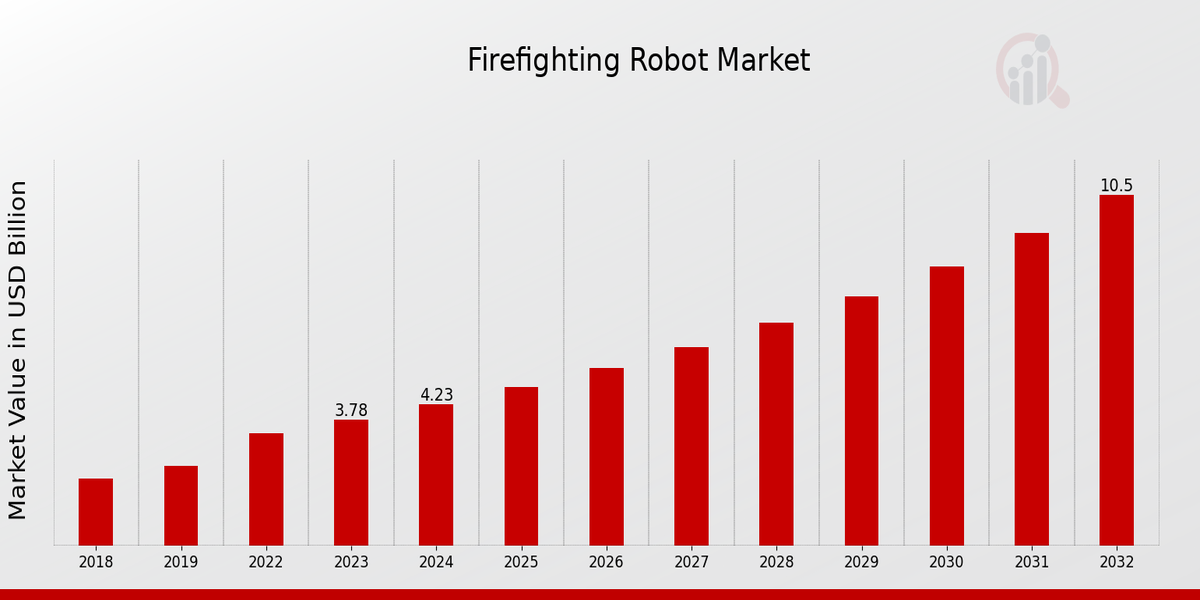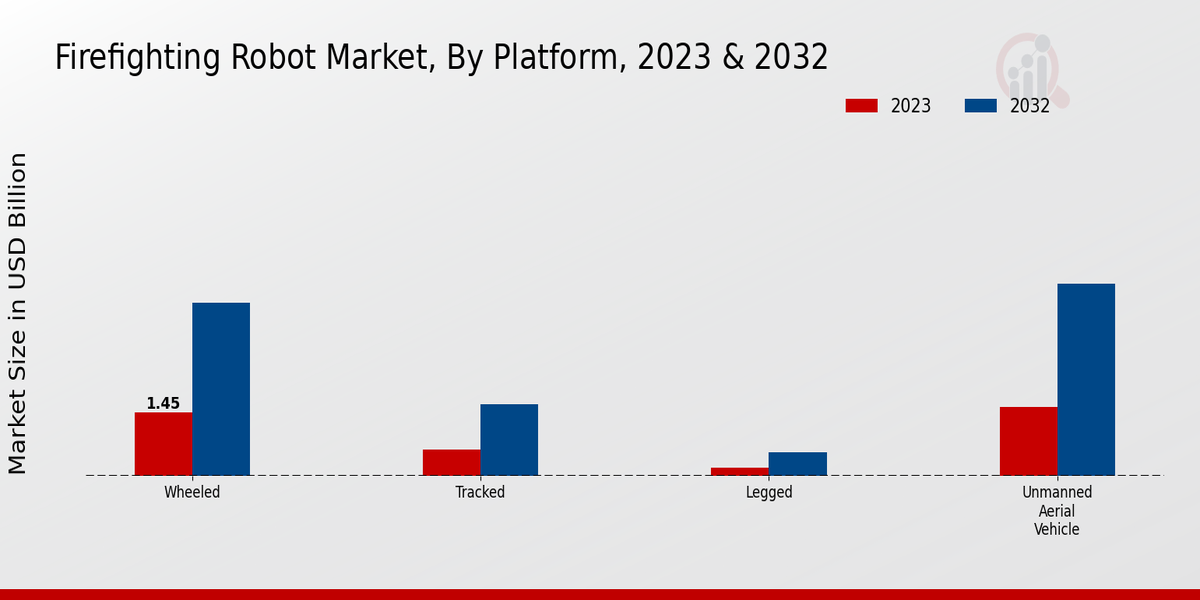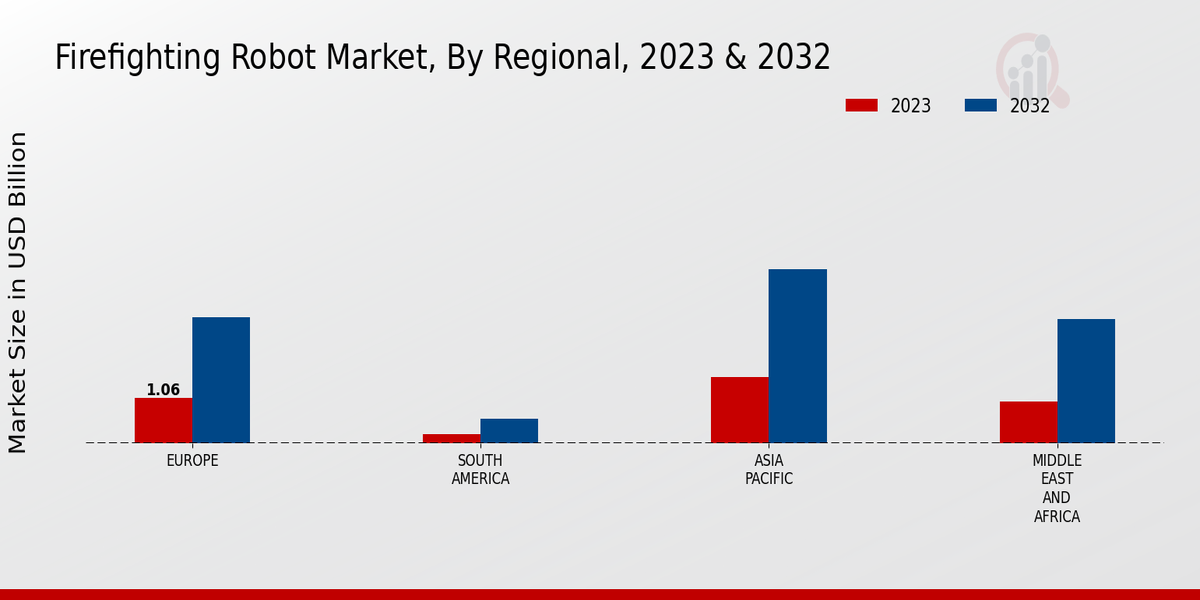Global Firefighting Robot Market Overview
Firefighting Robot Market Size was estimated at 3.78 (USD Billion) in 2023.The Firefighting Robot Market Industry is expected to grow from 4.23 (USD Billion) in 2024 to 10.5 (USD Billion) by 2032. The Firefighting Robot Market CAGR (growth rate) is expected to be around 12.02% during the forecast period (2024 - 2032).

Source Primary Research, Secondary Research, MRFR Database and Analyst Review
Key Firefighting Robot Market Trends Highlighted
The market for firefighting robot systems is expected to witness decent growth in the years to come. This growth is attributed to the increasing needs for firefighting robotic options which improves the service efficiency and protects human firefighters. The current popularity of integrating complex features such as artificial intelligence and machine learning, and their use in firefighting robots will also increase the sales of such equipment across the regions. There is also a growing trend of introducing technologies that enable remote fire fighting so as to enhance efficiency and speed especially when conditions are not clean. In addition, there are also opportunities created by increased housing insecurity and the stresses of wild and urban fires which require robots to mitigate hazards to firefighters. Major developments in the market include robots that are more mobile, have better sensors and cameras, and a degree of autonomy in navigation. This technology is very essential in combating fires as they enhance the operational capabilities of the firefighting robots within adverse conditions, thus replacing the firefighters.
Firefighting Robot Market Drivers
Increasing Demand for Enhanced Fire Safety Measures
With the rapid growth of the world’s population and increased urbanization, there is a rising demand for enhanced fire safety measures. In this context, firefighting robots present a unique solution due to their high efficiency and improved capabilities in terms of fire fighting and overall safety of human lives and property. Each year, the governments and organizations allocate substantial investments to upgrade their fire safety infrastructure, thus, representing a major driving force for the firefighting robot market.At the same time, the primary demand forces in the target market include the regions affected by the high level of fires, such as urban environments and industrial zones that are populated with people and thus require additional safety measures. By implementing the advanced technologies, such as AI, computer vision, autonomous navigation, the developers continue to improve their products, enabling the establishment of such features as the ability to navigate in hazardous environment, detection and fire suppression in an early stage, support of the firefighters and more.Thus, it is expected that, in the future, the adoption of the firefighting robots will only keep accelerating due to the increased attention to the public safety and the pressing demand to facilitate the effective management of fire hazards.
Technological Advancements and Innovation
The firefighting robot market is witnessing rapid advancements in technology, driven by ongoing research and development efforts. Manufacturers are constantly innovating to enhance the capabilities and performance of firefighting robots. The integration of AI, machine learning, and sensor technologies has led to the development of robots with improved situational awareness, decision-making abilities, and autonomous navigation. These advancements have significantly expanded the scope of applications for firefighting robots, enabling them to perform tasks such as search and rescue operations, hazardous materials handling, and remote fire suppression.Furthermore, the development of modular and customizable robots allows for tailored solutions to meet the specific requirements of different fire departments and industries. The continuous innovation in firefighting robot technology is a key driver of market growth, as it opens up new possibilities for enhancing fire safety and efficiency.
Growing Adoption in Industrial and Commercial Sectors
Firefighting robots are gaining increasing adoption in various industrial and commercial sectors beyond traditional fire departments. Industries such as manufacturing, mining, oil and gas, and transportation are recognizing the benefits of deploying firefighting robots to proactively prevent and manage fire risks. These robots can be equipped with specialized sensors to detect hazardous chemicals, flammable materials, and electrical faults, enabling early intervention and reducing the likelihood of catastrophic events.Additionally, firefighting robots can be deployed in confined spaces, extreme temperatures, and other hazardous environments where human firefighters may face risks. The adoption of firefighting robots in industrial and commercial settings enhances operational safety, reduces downtime, and protects valuable assets. As industries prioritize risk management and business continuity, the demand for firefighting robots in these sectors is anticipated to rise significantly.
Firefighting Robot Market Segment Insights
Firefighting Robot Market Platform Insights
The Firefighting Robot Market is segmented based on platform into wheeled, tracked, legged, and unmanned aerial vehicle (UAV). Among these, the wheeled segment held the largest market share in 2023 and is expected to continue its dominance throughout the forecast period. The growth of the wheeled segment can be attributed to the increasing adoption of wheeled firefighting robots for indoor applications, such as warehouses, shopping malls, and airports. Wheeled robots offer several advantages over other types of robots, including high mobility, maneuverability, and stability.They are also relatively easy to operate and maintain. The tracked segment is expected to witness significant growth during the forecast period. Tracked robots are well-suited for outdoor applications, such as firefighting in forests, fields, and uneven terrain. They offer superior traction and stability compared to wheeled robots, making them ideal for navigating over rough surfaces. The legged segment is expected to gain traction in the coming years. Legged robots offer unique advantages over wheeled and tracked robots, such as the ability to climb stairs, walk over obstacles, and operate in confined spaces.They are particularly well-suited for firefighting in complex and challenging environments, such as collapsed buildings and disaster zones. The UAV segment is expected to witness moderate growth during the forecast period. UAVs offer the ability to provide aerial surveillance, and firefighting capabilities. The growth of the market can be attributed to the increasing demand for firefighting robots from various end-user industries, such as fire departments, industrial facilities, and military organizations.

Source Primary Research, Secondary Research, MRFR Database and Analyst Review
Firefighting Robot Market Application Insights
The Firefighting Robot Market is segmented by Application as Fire Suppression, Fire Detection, Search and Rescue, and Hazardous Material Handling. Fire Suppression is expected to occupy the largest share of the market in 2023 and expected to exceed a share of 40% of the Firefighting Robot Market revenue. Based on the Application, the market is segmented into Fire Detection, Search and Rescue, and Hazardous Material Handling. Search and Rescue segment is expected to grow at the highest CAGR, as firefighting robots are used in disaster reliefs and useful for locating victims in harsh terrains.Handling of Hazardous Material is also gaining traction since the robotic systems ensure safe handling of the hazardous materials.
Firefighting Robot Market Autonomy Level Insights
Teleoperated systems accounted for the largest revenue share in 2023 and are expected to maintain their dominance over the forecast period. The growth of this segment can be attributed to the fact that teleoperated systems provide a high level of control and flexibility to operators, allowing them to respond quickly and effectively to fire emergencies. However, semi-autonomous and autonomous systems are expected to witness significant growth in the coming years, owing to their ability to perform tasks without human intervention, thereby reducing the risk to firefighters.In 2024, the Firefighting Robot Market was valued at 4.07(USD Billion) which is expected to reach 11.7(USD Billion) by 2032, exhibiting a CAGR of 12.5% during the forecast period.
Firefighting Robot Market Payload Insights
The Firefighting Robot Market segmentation by Payload includes Fire Extinguishing Agents, Cameras and Sensors, Communication Equipment, Tools and Equipment. The Fire Extinguishing Agents segment is expected to hold the largest share of the market in 2023, owing to the increasing demand for firefighting robots with advanced firefighting capabilities. The Cameras and Sensors segment is expected to witness significant growth over the forecast period, due to the rising adoption of computer vision and artificial intelligence in firefighting robots.The Communication Equipment segment is expected to account for a notable share of the market, as firefighting robots require reliable and secure communication systems to operate effectively. The Tools and Equipment segment is expected to grow steadily, driven by the demand for specialized tools and equipment for firefighting operations.
Firefighting Robot Market Size Insights
The Firefighting Robot Market is segmented by size into small (under 100 kg), medium (100-500 kg), and large (over 500 kg). The medium segment is expected to hold the largest market share in 2023 and is projected to continue to grow at the highest CAGR during the forecast period. This growth is attributed to the increasing demand for medium-sized firefighting robots for industrial and commercial applications, as they offer a balance between maneuverability and power. Small-sized firefighting robots are expected to witness a significant growth rate due to their use in confined spaces and for specialized tasks.Large-sized firefighting robots are primarily used for large-scale firefighting operations and are expected to account for a significant share of the market by 2032. The growth of the Firefighting Robot Market is driven by factors such as increasing urbanization, rising fire incidents, and growing awareness about fire safety regulations.
Firefighting Robot Market Regional Insights
The regional segmentation of the Firefighting Robot Market presents distinct market dynamics and growth opportunities. North America holds a significant market share, driven by advanced infrastructure, technological advancements, and stringent fire safety regulations. Europe follows closely, with a focus on research and development and a strong industrial base. The Asia-Pacific (APAC) region is projected to witness substantial growth, fueled by rapid urbanization, industrialization, and government initiatives to enhance fire safety. South America and the Middle East and Africa (MEA) regions are expected to experience steady growth, with increasing demand for firefighting robots in commercial and industrial sectors.

Source Primary Research, Secondary Research, MRFR Database and Analyst Review
Firefighting Robot Market Key Players and Competitive Insights
Major players in the Firefighting Robot Market are consistently looking for ways to improve their offerings and gain a competitive edge. They are investing in research and development to create more advanced and efficient firefighting robots. Leading Firefighting Robot Market players are also forming strategic partnerships and alliances to expand their reach and market share. The Firefighting Robot Market industry is highly competitive, with a number of major players vying for market share. Some of the leading players in the market include Boston Dynamics, Endeavor Robotics, iRobot, Roboteam, and TerraSentia. These companies offer a wide range of firefighting robots, from small, agile units that can navigate tight spaces to larger, more powerful robots that can extinguish large fires. The Firefighting Robot Market is expected to see continued growth in the coming years, as more and more fire departments adopt these technologies.Boston Dynamics is a leading developer of firefighting robots. The company's Spot robot is a small, agile robot that can navigate tight spaces and climb stairs. Spot is equipped with a variety of sensors and cameras that allow it to map its surroundings and identify potential hazards. The robot can also be equipped with a variety of tools, including a hose, a camera, and a manipulator arm. Boston Dynamics is also developing a larger firefighting robot called Atlas. Atlas is a humanoid robot that is capable of walking, climbing, and manipulating objects. The robot is equipped with a variety of sensors and cameras that allow it to navigate its surroundings and identify potential hazards. Atlas can also be equipped with a variety of tools, including a hose, a camera, and a manipulator arm.Roboteam is another leading developer of firefighting robots. The company's NERVA robot is a small, agile robot that can navigate tight spaces and climb stairs. NERVA is equipped with a variety of sensors and cameras that allow it to map its surroundings and identify potential hazards. The robot can also be equipped with a variety of tools, including a hose, a camera, and a manipulator arm. Roboteam is also developing a larger firefighting robot called Proteus. Proteus is a tracked robot that is capable of carrying a variety of payloads, including a hose, a camera, and a manipulator arm. Proteus is also equipped with a variety of sensors and cameras that allow it to navigate its surroundings and identify potential hazards.
Key Companies in the Firefighting Robot Market Include
- Kongsberg Gruppen
- L3 Technologies
- Shark Robotics
- Yanmar Holdings
- Howe Howe Technologies
- Boston Dynamics
- Endeavor Robotics
- Lockheed Martin
- Roboteam
- Mistral Solutions
- Oceaneering International
- SAFRAN Group
- Teledyne Technologies
- Clearpath Robotics
- Remotec
Firefighting Robot Market Industry Developments
The firefighting robot market is anticipated to reach a valuation of USD 10.5 billion by 2032, expanding at a CAGR of 12.02% from 2024 to 2032. This growth can be attributed to the increasing adoption of advanced technologies and the growing demand for efficient and safe firefighting solutions. Recent developments include the launch of new firefighting robots with enhanced capabilities, such as the use of AI and autonomous navigation systems. Moreover, government initiatives and regulations promoting the adoption of advanced firefighting technologies are further driving market expansion. Key players in the market are focusing on strategic partnerships and collaborations to enhance their product offerings and expand their geographical reach.
Firefighting Robot Market Segmentation Insights
Firefighting Robot Market Platform Outlook
- Wheeled
- Tracked
- Legged
- Unmanned Aerial Vehicle (UAV)
Firefighting Robot Market Application Outlook
- Fire Suppression
- Fire Detection
- Search and Rescue
- Hazardous Material Handling
Firefighting Robot Market Autonomy Level Outlook
- Teleoperated
- Semi-autonomous
- Autonomous
Firefighting Robot Market Payload Outlook
- Fire Extinguishing Agents
- Cameras and Sensors
- Communication Equipment
- Tools and Equipment
Firefighting Robot Market Size Outlook
- Small (Under 100 kg)
- Medium (100-500 kg)
- Large (Over 500 kg)
Firefighting Robot Market Regional Outlook
- North America
- Europe
- South America
- Asia Pacific
- Middle East and Africa
Firefighting Robot Market Report Scope
| Report Attribute/Metric |
Details |
| Market Size 2023 |
3.78 (USD Billion) |
| Market Size 2024 |
4.23 (USD Billion) |
| Market Size 2032 |
10.5(USD Billion) |
| Compound Annual Growth Rate (CAGR) |
12.02% (2024 - 2032) |
| Report Coverage |
Revenue Forecast, Competitive Landscape, Growth Factors, and Trends |
| Base Year |
2023 |
| Market Forecast Period |
2024 - 2032 |
| Historical Data |
2019 - 2023 |
| Market Forecast Units |
USD Billion |
| Key Companies Profiled |
Kongsberg Gruppen, L3 Technologies, Shark Robotics, Yanmar Holdings, Howe Howe Technologies, Boston Dynamics, Endeavor Robotics, Lockheed Martin, Roboteam, Mistral Solutions, Oceaneering International, SAFRAN Group, Teledyne Technologies, Clearpath Robotics, Remotec |
| Segments Covered |
Platform, Application, Autonomy Level, Payload, Size, Regional |
| Key Market Opportunities |
Smart home adoption Growing IoT integration Increasing demand for fire safety Government investments Technological advancements |
| Key Market Dynamics |
Technological Advancements Growing Demand from Fire Departments Government Initiatives Industry Collaborations Increasing Wildfires and Natural Disasters |
| Countries Covered |
North America, Europe, APAC, South America, MEA |
Frequently Asked Questions (FAQ) :
The Firefighting Robot Market is expected to reach a value of 10.5 USD Billion by 2032.
The market is anticipated to have a CAGR of 12.02% during the period from 2024 to 2032.
North America is projected to dominate the market with a value of 3.3 USD Billion in 2032.
The Wheeled platform segment is expected to be valued at 3.21 USD Billion in 2032.
Companies such as Kongsberg Gruppen and Boston Dynamics are recognized as key players in the market.
The Tracked platform segment is projected to reach 2.88 USD Billion in 2032.
The Asia Pacific region is anticipated to contribute a market value of 2.5 USD Billion by 2032.
The Legged platform segment is expected to be valued at 2.21 USD Billion in 2032.
The Unmanned Aerial Vehicle (UAV) segment is projected to reach 2.15 USD Billion in 2032.
The South America region is expected to grow to a market value of 0.8 USD Billion by 2032.

















